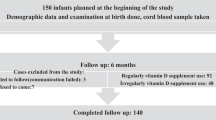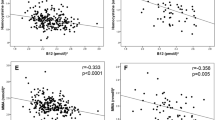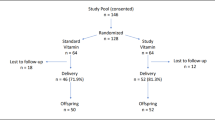Abstract
Background/objectives:
Maternal nutrient supplementation in developing countries is generally restricted to provision of iron and folic acid. Along with folic acid, vitamin B12 is also an important determinant of fetal growth and development. During pregnancy, the increased requirement of folic acid is met with supplementation, while vitamin B12 remains untreated and possibly deficient. The objective of our study was to study the combined effect of maternal plasma folate and vitamin B12, and their ratio on birth anthropometrics.
Subjects/methods:
We carried out an observational study on 49 full-term pregnant women at KEM Hospital, Pune, India, during 2006–2008, and measured plasma folate, vitamin B12 and homocysteine in venous blood at 36 weeks of gestation. Neonatal anthropometrics (birth weight, length, head circumference, abdominal circumference, mid arm circumference, chest circumference, triceps skinfold and subscapular skinfold thickness) were measured within 24 h of birth.
Results:
Maternal plasma folate and vitamin B12 were not correlated to neonatal anthropometrics. The combined association of folate and vitamin B12 expressed as folate to vitamin B12 ratio was correlated to the neonatal anthropometrics. Imbalance in the maternal micronutrients with increasing ratio of folate to vitamin B12 was associated with an increase in plasma homocysteine (P=0.014), lowering of neonatal birth weight (P=0.009), birth length (P=0.034), head circumference (P=0.018) and chest circumference (P=0.009), while no significant association to other anthropometrics was observed.
Conclusions:
Supplementation of vitamin B12 in addition to supplementation of folic acid in pregnancy may be important for improving birth weight, birth length, head circumference and chest circumference.
This is a preview of subscription content, access via your institution
Access options
Subscribe to this journal
Receive 12 print issues and online access
$259.00 per year
only $21.58 per issue
Buy this article
- Purchase on Springer Link
- Instant access to full article PDF
Prices may be subject to local taxes which are calculated during checkout


Similar content being viewed by others
References
Neggers YH, Goldenberg RL, Tamura T, Cliver SP, Hofman HJ . The relationship between maternal dietary intake and infant birth weight. Acta Obstet Gynecol Scand 1997; 165: S71–S75.
Walj NJ, Law MR, Morris JK, Wald DS . Quantifying the effect of folic acid. Lancet 2001; 358: 2069–2073.
Yajnik CS, Deshpande SS, Jackson AA, Refsum H, Rao S, Fisher DJ et al. Vitamin B12 and folate concentrations during pregnancy and insulin resistance in offspring: the Pune Maternal Nutrition Study. Diabetologia 2008; 51: 29–38.
Yajnik CS, Lubree HG, Thuse NV, Ramdas LV, Deshpande SS, Deshpande V et al. Oral vitamin B12supplementation reduces plasma total homocysteine concentration in women in India. Asia Pac J Clin Nutr 2007; 16: 103–109.
Green R, Miller JW . Folate deficiency beyond megaloblastic anemia: hyperhomocysteinemia and other manifestations of dysfunctional folate status. Semin Haematol 1999; 36: 47–64.
Swanson DA, Liu ML, Baker PJ, Garrett L, Stitzel M, Jianmin WU et al. Targeted disruptions of the methionine synthase gene in mice. Mol Cell Biol 2001; 21: 1058–1065.
Ueland PM, Bjrke Monsen AL . Hyperhomocysteinemia and B-vitamin deficiencies in infants and children. Clin Chem Lab Med 2003; 41: 1418–1426.
Obeid R, Herrmann W . Homocysteine folic acid and vitamin B12in relation to pre and postnatal health aspects. Clin Chem Lab Med 2005; 43: 1052–1057.
Ronnenberg AG, Goldman MB, Chen D, Aitken IW, Willett WC, Selhub J et al. Preconception homocysteine and B vitamin status and birth outcomes in Chinese women. Am J Clin Nutr 2002; 76: 1385–1391.
Yajnik CS, Deshpande SS, Panchanadikar AV, Naik SS, Deshpande JA, Coyaji KJ et al. Maternal total homocysteine concentration and neonatal size in India. Asia Pac J Clin Nutr 2005; 14: 179–181.
Murphy MM, Scott JM, Arija V, Molloy AM, Fernandez- Ballart JD . Maternal homocysteine before conception and throughout pregnancy predicts foetal homocysteine and birth weight. Clin Chem 2004; 50: 1406–1412.
Cohen J . Statistical Power Analysis for the Behavioral Sciences 2nd edn Lawrence Earlbaum Associates: Hillsdale, NJ, 1998, pp 273–406.
Steijns LS, Braams-Wiatrowska JK, Luiting HJ, van der Weide J . Evaluation of nonisotopic binding assays for measuring vitamin B 12 and folate in serum. Clin Chem Acta 1996; 248: 135–141.
Lonati S, Novembrino C, Ippolito S, Accinni R, Galli C, Troonen H et al. Analytical performance and method comparison study of the total homocysteine fluorescence polarization immunoassay (FPIA) on AxSYM analyzer. Clin Chem Lab Med 2004; 42: 228–234.
Uma Khanduri Archna, Sharma Arti Joshi . Occult folate and cobalamin deficiency in Indians. Natl Med J Ind 2005; 18: 4.
Naik S, Joglekar C, Bhat D, Lubree H, Rege S, Raut K et al. Marked gender difference in plasma total homocysteine concentrations in Indian adults with low vitamin B12 . Int J Vitamin Nutr Res 2011; 81: 306–316.
Rao S, Yajnik CS, Kanade A, Fall CH, Margetts BM, Jackson AA et al. Intake of Micronutrient-rich foods in rural Indian mothers is associated with the size of their babies at birth: Pune Maternal Nutrition Study. J Nutr 2001; 131: 1217–1224.
Gopalan C . Low birthweight: Significance and Implications. In: Sachdev HPS, Chaudhary P (eds) Nutrition in Children: Developing Country Concerns. Imprint: New Delhi, India, 1994, pp 1–33.
Barker DJ . Fetal origin of coronary heart disease. Br Med J 1995; 311: 171–174.
Martin H, Lindblad B, Norman M . Endothelial function in newborn infants is related to folate levels and birthweight. Pediatrics 2007; 119: 1152–1158.
Barker DJ . Adult consequences of fetal growth restriction. Clin Obstet Gynecol 2006; 49: 270–283.
Acknowledgements
We thank the Indian Council of Medical Research, New Delhi, grant number 63/3/Indo-US/2006-RHN, and the Eunice Kennedy Shriver National Institute of Child Health and Human Development, grant number R03HD052138, for funding the work. We also thank the research and medical staff at the KEM Hospital for enrolment and sample collection. We thank Dr CS Yajnik and Dr K Kumaran of the Diabetes Unit, KEM Hospital, Pune, for their valuable comments and suggestions on the paper. We also thank Dr Mehmood Sayyad for his help in statistical analysis of the data. The content is solely the responsibility of the authors and does not necessarily represent the official views of the ICMR or the National Institutes of Health.
Author information
Authors and Affiliations
Corresponding authors
Ethics declarations
Competing interests
The authors declare no conflict of interest.
Additional information
Supplementary Information accompanies this paper on European Journal of Clinical Nutrition website
Supplementary information
Rights and permissions
About this article
Cite this article
Gadgil, M., Joshi, K., Pandit, A. et al. Imbalance of folic acid and vitamin B12 is associated with birth outcome: an Indian pregnant women study. Eur J Clin Nutr 68, 726–729 (2014). https://doi.org/10.1038/ejcn.2013.289
Received:
Revised:
Accepted:
Published:
Issue Date:
DOI: https://doi.org/10.1038/ejcn.2013.289
Keywords
This article is cited by
-
Effects of maternal folate and vitamin B12 on gestational diabetes mellitus: a dose-response meta-analysis of observational studies
European Journal of Clinical Nutrition (2022)
-
A root cause analysis of sub-optimal uptake and compliance to iron and folic acid supplementation in pregnancy in 7 districts of Zambia
BMC Pregnancy and Childbirth (2020)
-
Higher maternal plasma folate, vitamin B12 and homocysteine levels in women with preeclampsia
Journal of Human Hypertension (2019)
-
Study protocol: Mother and Infant Nutritional Assessment (MINA) cohort study in Qatar and Lebanon
BMC Pregnancy and Childbirth (2016)
-
The association between maternal dietary micronutrient intake and neonatal anthropometry – secondary analysis from the ROLO study
Nutrition Journal (2015)



